OCZ Vertex 4 Review (256GB, 512GB)
by Anand Lal Shimpi on April 4, 2012 9:00 AM ESTAnandTech Storage Bench 2011
Two years ago we introduced our AnandTech Storage Bench, a suite of benchmarks that took traces of real OS/application usage and played them back in a repeatable manner. I assembled the traces myself out of frustration with the majority of what we have today in terms of SSD benchmarks.
Although the AnandTech Storage Bench tests did a good job of characterizing SSD performance, they weren't stressful enough. All of the tests performed less than 10GB of reads/writes and typically involved only 4GB of writes specifically. That's not even enough exceed the spare area on most SSDs. Most canned SSD benchmarks don't even come close to writing a single gigabyte of data, but that doesn't mean that simply writing 4GB is acceptable.
Originally I kept the benchmarks short enough that they wouldn't be a burden to run (~30 minutes) but long enough that they were representative of what a power user might do with their system.
Not too long ago I tweeted that I had created what I referred to as the Mother of All SSD Benchmarks (MOASB). Rather than only writing 4GB of data to the drive, this benchmark writes 106.32GB. It's the load you'd put on a drive after nearly two weeks of constant usage. And it takes a *long* time to run.
1) The MOASB, officially called AnandTech Storage Bench 2011 - Heavy Workload, mainly focuses on the times when your I/O activity is the highest. There is a lot of downloading and application installing that happens during the course of this test. My thinking was that it's during application installs, file copies, downloading and multitasking with all of this that you can really notice performance differences between drives.
2) I tried to cover as many bases as possible with the software I incorporated into this test. There's a lot of photo editing in Photoshop, HTML editing in Dreamweaver, web browsing, game playing/level loading (Starcraft II & WoW are both a part of the test) as well as general use stuff (application installing, virus scanning). I included a large amount of email downloading, document creation and editing as well. To top it all off I even use Visual Studio 2008 to build Chromium during the test.
The test has 2,168,893 read operations and 1,783,447 write operations. The IO breakdown is as follows:
| AnandTech Storage Bench 2011 - Heavy Workload IO Breakdown | ||||
| IO Size | % of Total | |||
| 4KB | 28% | |||
| 16KB | 10% | |||
| 32KB | 10% | |||
| 64KB | 4% | |||
Only 42% of all operations are sequential, the rest range from pseudo to fully random (with most falling in the pseudo-random category). Average queue depth is 4.625 IOs, with 59% of operations taking place in an IO queue of 1.
Many of you have asked for a better way to really characterize performance. Simply looking at IOPS doesn't really say much. As a result I'm going to be presenting Storage Bench 2011 data in a slightly different way. We'll have performance represented as Average MB/s, with higher numbers being better. At the same time I'll be reporting how long the SSD was busy while running this test. These disk busy graphs will show you exactly how much time was shaved off by using a faster drive vs. a slower one during the course of this test. Finally, I will also break out performance into reads, writes and combined. The reason I do this is to help balance out the fact that this test is unusually write intensive, which can often hide the benefits of a drive with good read performance.
There's also a new light workload for 2011. This is a far more reasonable, typical every day use case benchmark. Lots of web browsing, photo editing (but with a greater focus on photo consumption), video playback as well as some application installs and gaming. This test isn't nearly as write intensive as the MOASB but it's still multiple times more write intensive than what we were running in 2010.
As always I don't believe that these two benchmarks alone are enough to characterize the performance of a drive, but hopefully along with the rest of our tests they will help provide a better idea.
The testbed for Storage Bench 2011 has changed as well. We're now using a Sandy Bridge platform with full 6Gbps support for these tests.
AnandTech Storage Bench 2011 - Heavy Workload
We'll start out by looking at average data rate throughout our heavy workload test:
The overall score here is in-line with the SF-2281 solutions and OCZ's Octane. Our heavy workload is fairly write intensive, so I honestly expected the Vertex 4 to top the charts. Looking at the read/write breakdown explains why though:
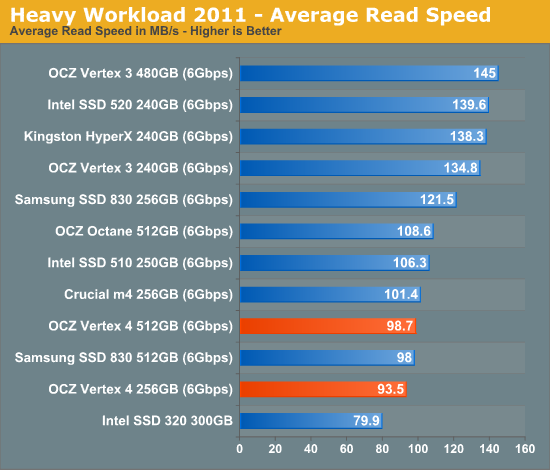
Here we see the Vertex 4's poor low queue-depth sequential read performance rearing its head once more. Look at the sequential write speed and you'll see where OCZ makes up for its shortcomings however. The Vertex 4 writes quicker than any drive we've tested.

It's a tough tradeoff to come to terms with. The Vertex 4 delivers performance when it matters the most, but typically you want the absolute best performance regardless of workload. All of this may become moot if OCZ is able to address the situation with a firmware update in the coming weeks like it promised, but for buyers today it is something you have to think about.
The next three charts just represent the same data, but in a different manner. Instead of looking at average data rate, we're looking at how long the disk was busy for during this entire test. Note that disk busy time excludes any and all idles, this is just how long the SSD was busy doing something:
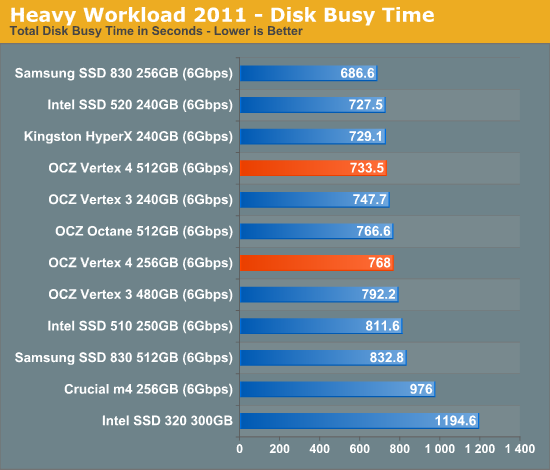
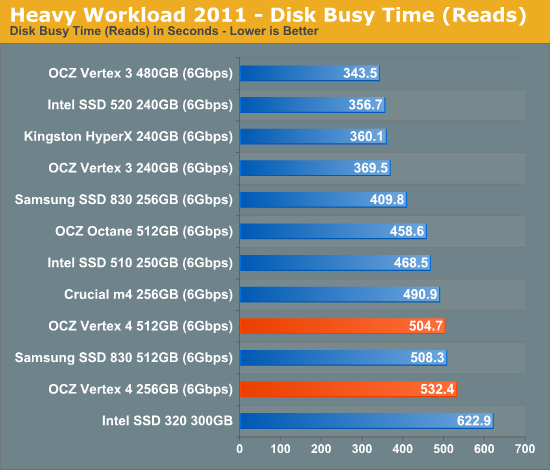
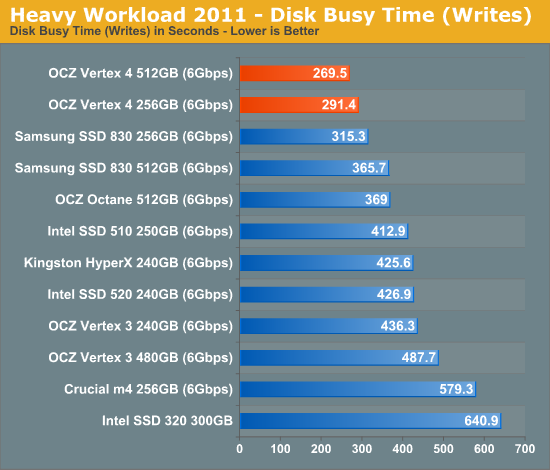


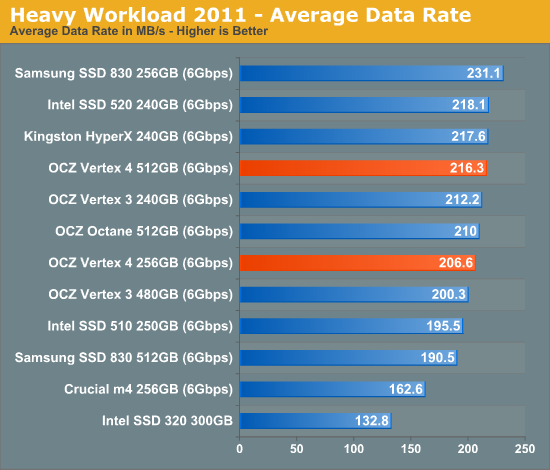








127 Comments
View All Comments
ViviTheMage - Wednesday, April 4, 2012 - link
mmmmmm, iops.LB-ID - Wednesday, April 4, 2012 - link
It's still a drive from OCZ, a company that has repeatedly and blatantly used its customer base as unpaid beta testers, and lambasted them when they dared to complain about it. No thank you. The fastest drive in the world is of no use to me if it's causing my computer to BSOD constantly. I'll be spending my money and that of my many clients on drives with proven track records for reliability and excellent customer service, both sadly lacking in OCZ products.hackztor - Wednesday, April 4, 2012 - link
Ocz is the only one that actually got to the bottom of the bsod screen on sandforce. In the end it was sandforce fault because they made the controller. All the other companies waited and then used the fix. Intel is the exception who waited a whole year before releasing them to validate but they still use sandforce controllers. Vertex4 is the 1st time that ocz now owns the controller and firmware that goes into the product. I hope this will prove to be better and have quicker fixes. Ocz is always the first to release the technology so expect some issues, but thats what people take for early adopting. I had 5 vertex 1 die on me and then they upgraded me to a vertex2. Just purchased the 4 so hope all goes well.taltamir - Wednesday, April 4, 2012 - link
"Ocz is the only one that actually got to the bottom of the bsod screen on sandforce."Actually that was intel.
hackztor - Wednesday, April 4, 2012 - link
Not true. Ocz pushed sandforce to finally find the issue based on what the users were telling ocz while sandforce kept trying to deny the issue and could not find it in a lab environment. If you see further down I said intel waited a year with validation going on.breakSSD - Thursday, April 5, 2012 - link
You have no idea about ssd validation if you think Ocz pushed sandforce for BSOD.The fact is that Intel found this and kept sandforce busy with fixing the issue while ocz even though knowing the issue release agility 3. Anyways doesn't matter who takes the credit, people know where to go when it comes to reliability.iceman98343 - Friday, April 6, 2012 - link
you do realize intel 520s are now getting bsods?!Obsoleet - Saturday, April 7, 2012 - link
You go to Samsung for reliability. Iceman is correct, word is spreading of more 520 stability issues. If you want the fastest, most reliable SSD get the 830 as Anand recommends.Einy0 - Saturday, April 7, 2012 - link
At work we have deployed about 50 - 80GB Intel 320 Series Drives and so far nearly 60 - 64GB Samsung 830 Drives. The Samsung drives are screamers but we've seen a lot of strange issues with the Samsung drives that we never had with the Intel drives. We have not had a single drive from either company fail or come DOA. That amazes me personally, not a single dud. We've literally had dozens of faculty members come ask us what we did to their computer that made it so fast all of a sudden. The issues we've had with the Samsung drives about 1 in 10 causes Windows mini-setup to freeze. We re-image the drive again it works just fine. We are thinking maybe the compatibility with some SATA controllers isn't as robust on the Samsung drives as it is on the Intel drives.gandx - Tuesday, April 24, 2012 - link
Or choose a SSD with a marvell controller like the Corsair Performance Pro or Plextor M3P. Both are fast and stable. I would never choose a SSD with sandforce again after using a vertex 3 for a while with lot or problems and i'm obviously not the only one.